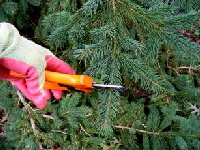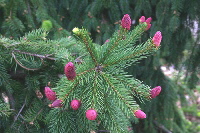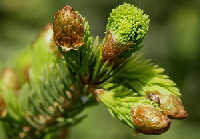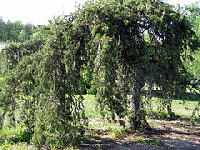How to Prune Evergreens
Pruning conifers is quite a bit different than pruning deciduous shrubs or trees, the broadleaf evergreens such as holly and boxwood are more similar to deciduous pruning. Ideally you should have little or no pruning necessary if you have planted conifers appropriate for your space. Conifers will always look best and be in the best health with little or no pruning at all. If you decide to prune a conifer, first make sure you have good reason for it, as incorrectly pruning an evergreen can permanently deform or even kill it.
Across much of the Midwest, homeowners and gardens centers tend to refer to conifers as simply evergreens. It is important to note here, that conifer evergreens includes not only the needled pines and spruce, but also the flat scaled leaf types such as arborvitae and cypress. (But as mentioned, NOT broad leaved evergreens such as gardenias, camellias, azaleas, hollies). It is common for arborvitae and similar evergreens to be severely pruned into submission. If you have had the opportunity to purchase and plant your own evergreens, you have probably discovered that the severe pruning we are accustomed to is completely unnecessary if the appropriate ultimate size of the plant fits the planting site. Not MATURE size, which is only about ten years growth, but ultimate size. Most evergreens will thrive for around 30 years if they are not beaten up with pruning every year, and of course they do keep growing through the lifespan. Generally their fastest growth period is the third through eighth year.
WHY PRUNE?
To remove dead or damaged branches
To maintain size
To maintain the health of the plant
To shape or train the plant
You will need to apply the appropriate pruning method for the evergreen species and reason for pruning. In order to understand pruning instructions it is helpful to understand a few terms specifically related to evergreens. Pruning instructions will often refer to these terms:
EVERGREEN TERMS
Broad leaved evergreens have foliage that are not needles
Candle is the leaf or needle buds that appear in early spring before the needles emerge
Central leader is the main stem, an extension of the trunk
Lateral branches extend from the main trunk
Terminal is the tip end of a branch.
Whorls are the lateral branches that are grouped around the central trunk
Internode is the space on the trunk between whorls.
Dieback is the apparent slow death of foliage on limbs or an entire plant. Symptoms displayed may be needle drop or foliage discoloration.
Dieback is the apparent slow death of foliage on limbs or an entire plant. Symptoms displayed may be needle drop or foliage discoloration.
WHEN TO PRUNE
Very late winter and very early spring before growth begins are generally good times to prune since the plant is not actively growing. But this is not true for every plant! There are certain plants that should be pruned at very specific times to prevent damage to the plant, so if there are specific instructions for your variety it is best to follow them. Probably the worst times to prune just about anything is late summer or early fall since new growth is encouraged that may not have time to harden off before winter, and in spring right after a new flush of growth has appeared. The plant has depleted it’s nutrients to form the new foliage and will be weakened if pruned in its’ depleted state.
Removed broken or damaged limbs can be done anytime. Allowing the damage to remain is often more harmful than pruning at the wrong time.
To do the best pruning job and preserve the natural growth form, it is best to look further to techniques for pruning specific varieties. We’ll start first with general pruning techniques before getting into specific species and cultivars.
GENERAL PRUNING TIPS FOR EVERGREEN CONIFERS
Conifers in general should be pruned as little as possible.
Although for most varieties timing is not critical, but the best time to prune most conifers is winter or very early spring before growth begins.
The next best time for pruning is after the new season’s growth is complete, generally in late June or July.
Minimal pruning is best, but if you have made the mistake of planting a conifer too large for its’ space you can remove up to two thirds of new growth for most species. Conifers are not easily able to generate new growth from old wood so removing all new growth may result in deformed or stunted growth or even kill it
Do not immediately prune out dieback. Carefully inspect the branch and tips for green or buds. If the tips are green new needles will be produced from the tip of the branch. But new needles will not grow along the length of the branch where needles have all fallen off.
If you plan to partially remove any branch, make sure to leave live green shoots at the tip or the branch will die.
Remember that conifers do not recover quickly from mistakes, so be sure before you cut.
Never “top” a large pyramid shaped conifer. Removing the central leader results in an unsightly, malformed, weakened tree that is susceptible to decay and disease. The “top” central leader is the most productive part of the crown. (Growers and experienced gardeners may “top” certain small pines to produce compact pyramid forms, this requires specific and repeated pruning.)
Finally, if you are not satisfied with the form you may want to work on the shaping of the evergreen. It is very important at this stage that you have observed the natural growth habit of the evergreen. If you choose the wrong pruning method to shape an evergreen you can destroy the natural form leaving a rather unsightly evergreen. Some will recover their form after a few to several years but some may never be quite as appealing. (More information follows regarding the best methods for each type of evergreen.)
PRUNING TECHNIQUES AND METHODS FOR CONIFERS
Shearing
Using a sharp hedge trimmer, shear back up to three inches of new growth. Shearing annually will maintain shape and form and is also a technique for controlling size.
Tip Pruning
Using a sharp hand pruner, cut off one half the length of all new candles in early spring. Tip pruning will encourage dense growth for a full plant.
Every pruning project should begin with the simple removal of dead, broken or diseased branches. This is often enough to freshen the conifer and open up the foliage for better entry of light and air to the inner growth. Do not immediately remove die back in early spring, needled conifers often simply drop winter damage as the new growth emerges. Clean up tips that have died back after new growth is complete. Severely damaged conifers can not be hard pruned (severely cut back) like many deciduous shrubs. They will rarely generate vigorous growth, creating an unsightly and deformed specimen, and may quite simply die completely. Yews and hemlocks are best able to generate new growth on old wood but you still cannot hard prune.
PRUNING TIPS FOR SPECIFIC CONIFERS
Little or no pruning is generally required for conifers. Simply remove any dead, damaged, diseased or crossed branches. Wayward branches can be removed to maintain form. Other than pines, narrow leaved evergreens should be pruned very early in spring
Pines
In early spring after the buds have grown to long candles but before the needles open out of the candles, prune or pinch back the candles to one half or one third the length. This will encourage dense compact growth. Do not remove the whole candle as little or no new growth will occur. Growth only occurs at the tips of the branches so don’t cut the whole branch back, as no new growth will occur.
Spruce, Fir, Douglas Fir and Cedar
These evergreens produce new growth each spring from the terminal buds. But new lateral growth can be encouraged by removing the terminal buds (the bud at the tip of each branch) or by cutting back to a lateral branch for more severe pruning. Ideally only about half of new growth should be pruned. Late winter or very early spring is the best time to tip prune spruce, fir and douglas fir.
Arborvitae and Juniper
Arborvitae and Juniper both take to shearing quite well to maintain size or shape. However, both species have dense foliage that results in a dead area on the interior. The inner branches simply do not get enough light and air to maintain and produce foliage. If foliage is removed up to the dead zone regrowth will not occur. Always make sure that green growth is left on every branch cut to prevent the branch from dying. New growth can be sheared back or thinned close to the dead zone, but you should try not to remove any more than two thirds of new growth. Prune early in the growing season, April or May depending on your growing zone. Pruning in mid to late summer will encourage growth that may not have time to harden off before winter.
Yew and Hemlock
Yew and Hemlock both produce growth buds along the length of the branches so the can be sheared or pruned at any point of the branches. Spring is the best time, before new growth begins, but they can be pruned at any time.
Larch
Although Larch tend to drop their needles in fall they are nonetheless considered an evergreen conifer. To maintain good form a Larch should only be pruned to remove dead, damaged, broken or diseased branches. Every attempt should be made to preserve the normal shape of the tree if pruning is necessary. If maintaining size is important it is best to perform minimal pruning every year, pruning or pinching off no more than the current year’s growth. When pruning is necessary it should be done from mid summer to late winter.
Cypress
False Cypress generally need little or no pruning other than light pruning to maintain shape. In general cypress evergreens take to shearing very well to maintain size or form. Most False Cypress have unique growth forms, especially the Threadleaf Cypress (Mops) which produces weeping branches. To maintain the unique shape, individual branches should be cut back to a joint. If you are not partial to the shaggy weeping appearance they do shear well to a more uniform shape.
Proceed slowly and carefully when pruning evergreens and take your time evaluating the growth form. When in doubt or if it’s a big job, you may want to just call in a professional.




